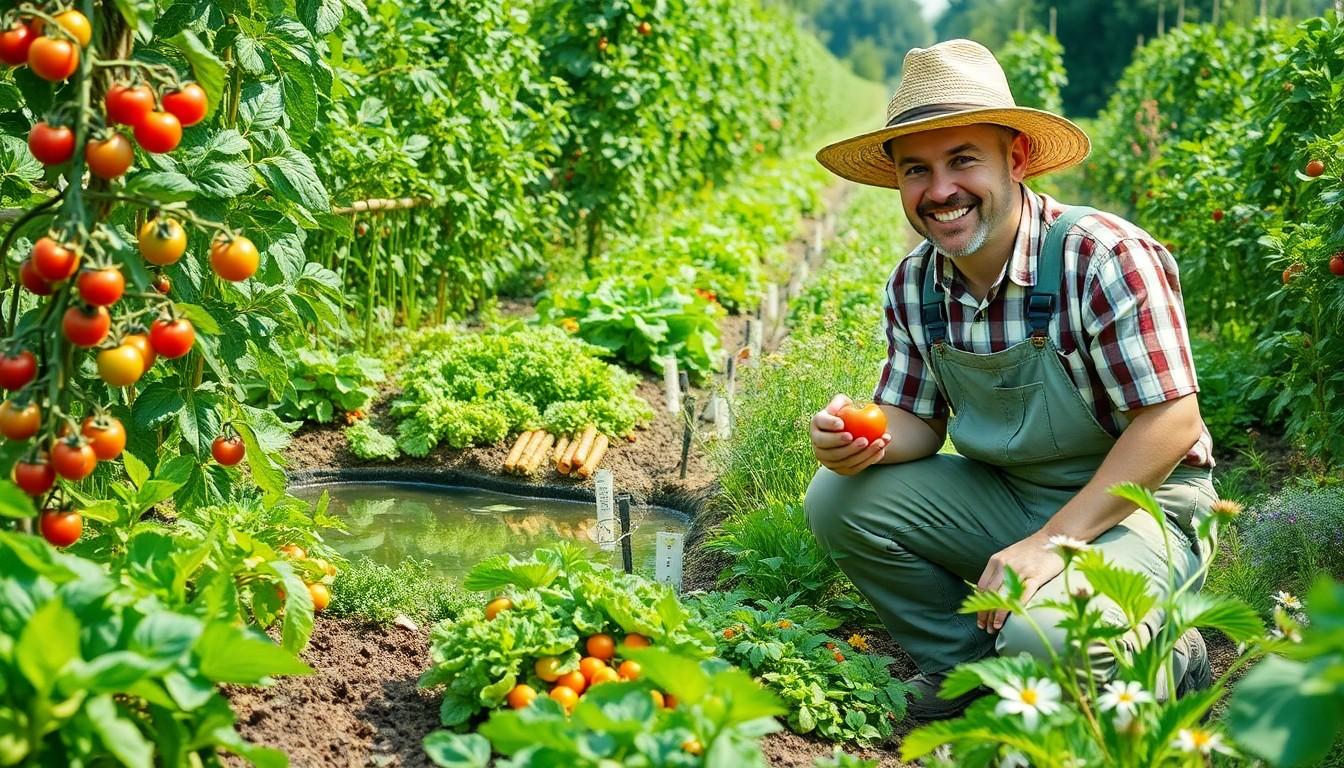Physical Address
304 North Cardinal St.
Dorchester Center, MA 02124

In a world where the quest for fresh and healthy food often feels like a treasure hunt, organic farming stands out like a shiny gold coin. Imagine biting into a juicy tomato that tastes like it was kissed by the sun, rather than plucked from a lab. Organic farming isn’t just a trend; it’s a lifestyle that nurtures the earth and our taste buds.
Organic farming encompasses various methods that promote sustainable agriculture. Crop rotation involves alternating different crops on the same land to enhance soil health and reduce pest pressures. Permaculture practices create self-sustaining agricultural ecosystems that work with natural local conditions.
Some farms adopt polyculture, where multiple crops grow together to increase biodiversity. Integrated pest management uses biological controls instead of chemical pesticides to minimize environmental impact. These examples highlight how farmers can grow food while respecting ecological balance.
Community-supported agriculture, or CSA, connects consumers directly with local farms. Customers subscribe to receive seasonal produce directly from farmers, fostering community relationships. Crop diversity in these systems supports resilience against pests and diseases.
Aquaponics combines fish farming with hydroponics, offering a closed-loop system where fish waste nourishes plants while plants clean water for fish. Vertical farming, often in urban settings, optimizes space by growing crops in stacked layers, enhancing efficiency and reducing transportation emissions.
Examples from around the world illustrate the success of organic farming. In California, flower farms utilize organic methods to create sustainable products while respecting their ecosystem. In Europe, organic vineyards use natural techniques to produce high-quality wines without synthetic chemicals.
Farmers demonstrate that organic methods yield significant benefits. They nurture the environment, promote biodiversity, and deliver nutritious food. As organic farming continues to expand, further innovative practices are likely to emerge, helping to shape modern agriculture sustainably.

Organic farming offers significant advantages, impacting both the environment and health positively. Sustainable practices play a crucial role in these benefits.
Organic farming enhances soil health and biodiversity. Crop rotation, permaculture, and polyculture improve nutrient cycles and support diverse ecosystems. Reduced chemical use fosters cleaner air and water. These practices minimize pollution and protect wildlife habitats. Certified organic methods lead to decreased carbon footprints. They also contribute to climate resilience by promoting better water management, which is essential in areas facing drought. Overall, organic farming creates a more balanced environment, supporting sustainable agricultural practices.
Increased nutrient density defines the health benefits of organic produce. Organic fruits and vegetables often contain higher levels of vitamins and minerals compared to conventionally grown counterparts. Reduced exposure to synthetic pesticides and fertilizers enhances safety for consumers. Studies indicate that organic farming methods can lower the risk of chronic illnesses associated with chemical exposure. Furthermore, fresh organic produce offers superior taste, making it a preferred choice for many. Supporting local organic farmers strengthens community health and economic well-being.
Organic farming finds implementation in various agricultural settings, showcasing its adaptability and benefits. Below are three notable case studies that illustrate different aspects of organic farming.
Organic vegetable farming exemplifies the successful integration of sustainable practices. Numerous farms across the United States utilize crop rotation to improve soil fertility and reduce pest issues. For instance, farms in California produce a variety of organic vegetables, including tomatoes, carrots, and lettuce. These farms often use companion planting techniques, enhancing biodiversity and yielding higher-quality produce. Composting serves as a vital practice, enriching soil with nutrients while reducing waste.
Organic fruit orchards represent another successful facet of organic farming. Orchards in regions like the Pacific Northwest prioritize the use of natural pesticides and encourage beneficial insects to control pests. Apples, pears, and berries thrive in these environments, growing without synthetic chemicals. These farms often implement cover cropping to improve soil structure and reduce erosion. Moreover, organic certification assures consumers of the quality and safety of the products, increasing market demand.
Organic livestock farms focus on animal welfare and sustainable practices. In these operations, animals are raised without antibiotics or growth hormones, promoting healthier livestock. Pasture-based systems allow livestock to forage naturally, improving animal health and enhancing flavor in the meat. Organic milk production emphasizes humane treatment and higher nutritional standards. These farms contribute to a more sustainable agricultural system by minimizing environmental impact while providing high-quality animal products.
Organic farming incorporates innovative practices that enhance sustainability and productivity. Key methods such as crop rotation and sustainable pest management create resilient agricultural systems.
Crop rotation involves alternating crops in the same field across seasons. This technique improves soil health by replenishing nutrients. Farmers can reduce pest pressure and prevent disease cycles effectively with varied crops. Growing legumes, for instance, adds nitrogen back to the soil, promoting fertility. Organic farmers often establish strategic sequences, rotating between deep-rooted and shallow-rooted species. These practices enhance biodiversity, leading to healthier ecosystems within fields. Notably, wheat, corn, and soy crops frequently alternate to maximize yield and sustainability in organic systems.
Sustainable pest management emphasizes natural solutions to control agricultural pests. Integrated pest management (IPM) is a critical component, utilizing beneficial insects to mitigate pest populations. Bio-pesticides derived from plant extracts or naturally occurring microbes offer eco-friendly alternatives to synthetic chemicals. Farmers also prepare trap crops to lure pests away from main harvests. Regular monitoring supports early detection, allowing prompt intervention. These strategies foster ecological balance, enhancing overall crop resilience. Successful organic operations often intertwine pest management techniques with diverse planting approaches, promoting long-term sustainability.
Organic farming stands as a transformative approach to agriculture that prioritizes health and sustainability. By embracing methods that enhance soil health and biodiversity, it not only produces flavorful and nutritious food but also nurtures the environment. The success stories from various regions illustrate the adaptability and effectiveness of organic practices across diverse agricultural settings.
As awareness of the benefits of organic farming grows, so does the potential for innovative solutions that further enhance its impact. Supporting local organic farmers fosters community well-being and strengthens the connection between consumers and their food sources. The future of agriculture looks promising with organic farming leading the way toward a healthier planet and population.